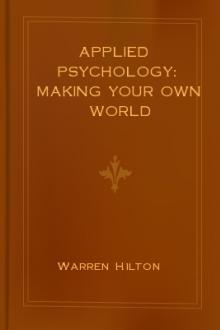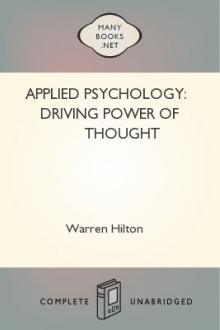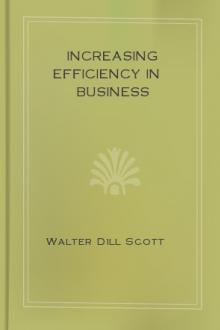Applied Psychology: Making Your Own World by Warren Hilton (books like beach read txt) 📖

- Author: Warren Hilton
- Performer: -
Book online «Applied Psychology: Making Your Own World by Warren Hilton (books like beach read txt) 📖». Author Warren Hilton
Aside from the obvious uses to which these sense-illusions can be put, they form the basis for a number of psychological experiments to test the abilities of persons in many ways. Here is a test which deals with the range of attention. If you desire to discover the capacity of any person to pay attention to unfamiliar questions or subjects which might at some future time have great importance, try this test. Have a piece of pasteboard cut into squares, circles, triangles, halfmoons, stars and other forms. Then write upon each piece some such word as hat, coat, ball or bat. The objects are then placed under a cloth cover and the subject to be examined is told to concentrate his attention on the shapes alone, paying no attention to the words. The cloth is lifted for five seconds and then replaced. The subject is then told to draw with a pencil the different shapes and such words as he may chance to remember. The experiment should then be repeated, with the injunction to pay no attention to the shapes but to remember as many words as possible, and write them down on such forms as he may happen to recall.
Of course, the real object is to determine whether the subject will see more than he is told, or whether he is a mere automaton. The result will tell whether his attention is of the narrow or broad type. If it be narrow, he will see only the forms in the first case and no words, and in the second case he will remember the words but be unable to recall the shape of the pieces of cardboard.
His breadth of attention will be shown by the number of correct forms and words combined which he is able to remember in both cases. In other words, this will measure his ability to pay attention to more than one thing at a time.
Other things being equal, the narrow type of attention belongs to a man fitted for work as a bookkeeper or mechanic, while the broad type of attention fits one for work as a foreman or superintendent or, lacking executive ability, for work requiring the supervision of mechanical operations widely separated in space.
The ordinary man sees but one thing at a time, while the exceptional man sees many things at every glance and is prepared to remember and act upon them in emergency.
Having determined a person's scope of attention, you may want to test his accuracy in details as compared with other men. To conduct such an experiment dictate a statement which will form one typewritten letterhead sheet. This statement should comprise facts and figures about your business of which the subjects to be tested are supposed to have accurate knowledge. After this original page is written, have your typist write out another set of sheets in which there are a large number of errors both in spelling and figures. Then have each of the persons to be examined go through one of these sheets and cross out all the wrong letters or figures. Time this operation. The man who does it in the quickest time and overlooks the fewest errors, naturally ranks highest in speed and accuracy of work.
Look into your own business and you will undoubtedly find some department, whether it be store decoration, office furnishing, window dressing, advertising, landscape work or architecture, in which a systematic application of a knowledge of sensory illusions will produce good results.
The aspect of the sense-perceptive process that deals with the relation of mind to environment is of greatest practical value.
Look at this subject for a moment and you will see that the world in which you live and work is a world of your own making. All the factors of success or failure are factors of your own choosing and creation.
If there is anything in the world you feel sure of, it is that you can depend upon the "evidence of your own senses," eyes, ears, nose, etc. You rest serene in the conviction that your senses picture the world to you exactly as it is. It is a common saying that "Seeing is believing."
Yet how can you be sure that any object in the external world is actually what your sense-perceptions report it to be?
You have learned that a countless number of physical agencies must intervene before your mind can receive an impression or message through any of the senses.
Under these conditions you cannot be sure that your impression of a green lamp-shade, for instance, comes through the same sort of etheric and cellular activities that convey a picture of the same lamp-shade to the brain of another. If the physical agencies through which your sense-impressions of the lamp-shade filter are not identical with the agencies through which they pass to the other person's brain, then your mental picture and his mental picture cannot be the same. You can never be sure that what both you and another may describe as green may not create an entirely different impression in your mind from the impression it creates in his.
Other facts add to your uncertainty. Thus, the same stimulus acting on different organs of sense will produce different sensations. A blow upon the eye will cause you to "see stars"; a similar blow upon the ear will cause you to hear an explosive sound. In other words, the vibratory effect of a touch on eye or ear is the same as that of light or sound vibrations.
The notion you may form of any object in the outer world depends solely upon what part of your brain happens to be connected with that particular nerve-end that receives an impression from the object.
You see the sun without being able to hear it because the only nerve-ends tuned to vibrate in harmony with the ether-waves set in action by the sun are nerve-ends that are connected with the brain center devoted to sight. "If," says Professor James, "we could splice the outer extremities of our optic nerves to our ears, and those of our auditory nerves to our eyes, we should hear the lightning and see the thunder, see the symphony and hear the conductor's movements."
In other words, the kind of impressions we receive from the world about us, the sort of mental pictures we form concerning it, in fact the character of the outer world, the nature of the environment in which our lives are cast—all these things depend for each one of us simply upon how he happens to be put together, simply upon his individual mental make-up.
There is another way of examining into the intervening agencies that influence our mental conception of the material world about us.
Look at the table or any other familiar object in the room in which you are sitting. Has it ever occurred to you that this object may have no existence apart from your mental impression of it? Have you ever realized that no object ever has been or ever could be known to exist unless there was an individual mind present to note its existence?
If you have never given much thought to questions of this kind, you will be tempted to answer boldly that the table is obviously a reality, that you have a direct intuitive knowledge of it, and that you can at once assure yourself of its existence by looking at it or touching it. You will conceive your perception of the table as a sort of projection of your mind comfortably enfolding the table within itself.
But perception is obviously only a state of mind. Can it, then, go outside of the mind to meet the table or even "hover in midair like a bridge between the two"? If you perceive the table, must not your perception of it exist wholly within your own mind? If, then, the table has any existence outside of and apart from your perception of it, then the table and your mental image of the table are two separate and distinct things.
In other words, you are on the horns of a dilemma. If you insist that the table exists outside of your mind, you must admit that your knowledge of it is not direct, immediate and intuitive, but indirect and representative, because of intervening physical agencies, and that the only thing directly known is the mental impression of the table. On the other hand, if you insist that your knowledge of the table is direct, immediate and intuitive you must admit that the table is only a mental image, a mental reality, if it is any sort of reality at all, and that it has no existence outside of the mind.
You may easily convince yourself that the table you directly perceive can be nothing other than a mental picture. How? Simply close your eyes. It has now ceased to exist. What has ceased to exist? The external table of wood and glue and bolts? By no means. Simply its mental duplicate. And by alternately opening and closing your eyes, you can successively create and destroy this mental duplicate.
Clearly, then, the table of which you are directly and immediately conscious when your eyes are open is always this mental duplicate, this aggregate of color, form, size and touch impressions; while the real table, the physical table, may be something other than the one of which you are directly aware. This other thing, this physical table, whatever it is, can never be directly known, if indeed it has any existence, a fact that many distinguished philosophers have had the courage to deny.
Imagine, then, for a moment that everything except mind should suddenly cease to exist, but that your sense-perceptions—that is to say, your perception of sensory impressions—were to continue to follow one another as before. Would not the physical world be for you just exactly what it is today, and would you not have the same reasons for believing in its existence that you now have?
And, conversely, if the world of matter were to go on, but all mental images, all perception of sense-impressions, were to come to an end, would not all matter be annihilated for you when your perceptions ceased?
It is obvious that the world is not the same for all of us; but that it is for each one of us simply the world of his individual perceptions.
The whole subject of sense-impressions, sensation and perception may, therefore, be looked at from the standpoint of the mind as an active influence, as well as from the standpoint of
 A very interesting statement of one of our contemporaries is that any person, to one degree or another, is both a psychologist and a philosopher - they say, life forces him to. On the one hand, the main driving force of every person is the craving for knowledge, the desire to reach certain social heights, the desire to be wise in any everyday situations - and this is the philosophy of life.
A very interesting statement of one of our contemporaries is that any person, to one degree or another, is both a psychologist and a philosopher - they say, life forces him to. On the one hand, the main driving force of every person is the craving for knowledge, the desire to reach certain social heights, the desire to be wise in any everyday situations - and this is the philosophy of life. 




Comments (0)